Assessment Center Case Studies Practice
VerifiedAdded on 2022/09/07
|9
|2624
|16
AI Summary
Contribute Materials
Your contribution can guide someone’s learning journey. Share your
documents today.
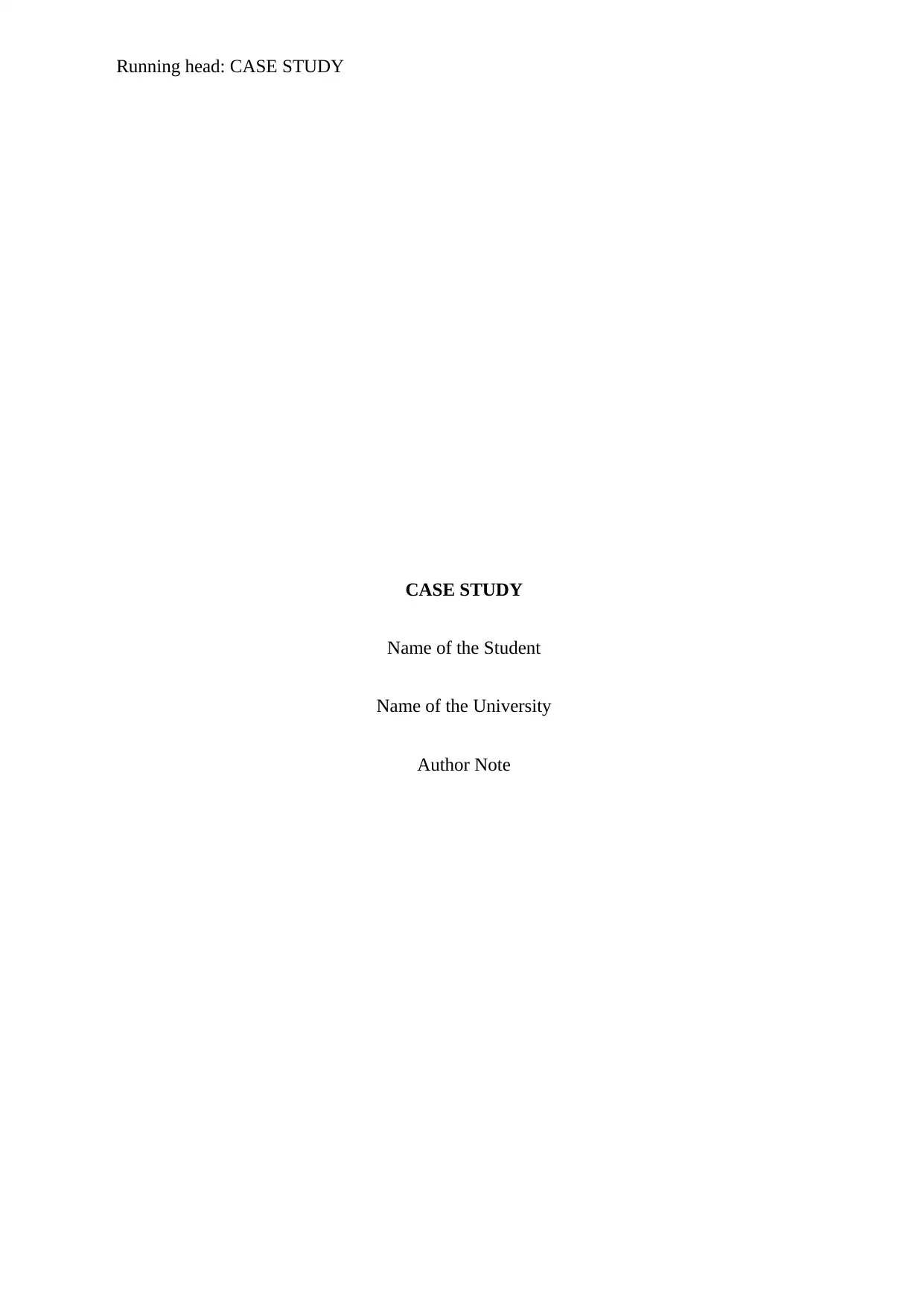
Running head: CASE STUDY
CASE STUDY
Name of the Student
Name of the University
Author Note
CASE STUDY
Name of the Student
Name of the University
Author Note
Secure Best Marks with AI Grader
Need help grading? Try our AI Grader for instant feedback on your assignments.
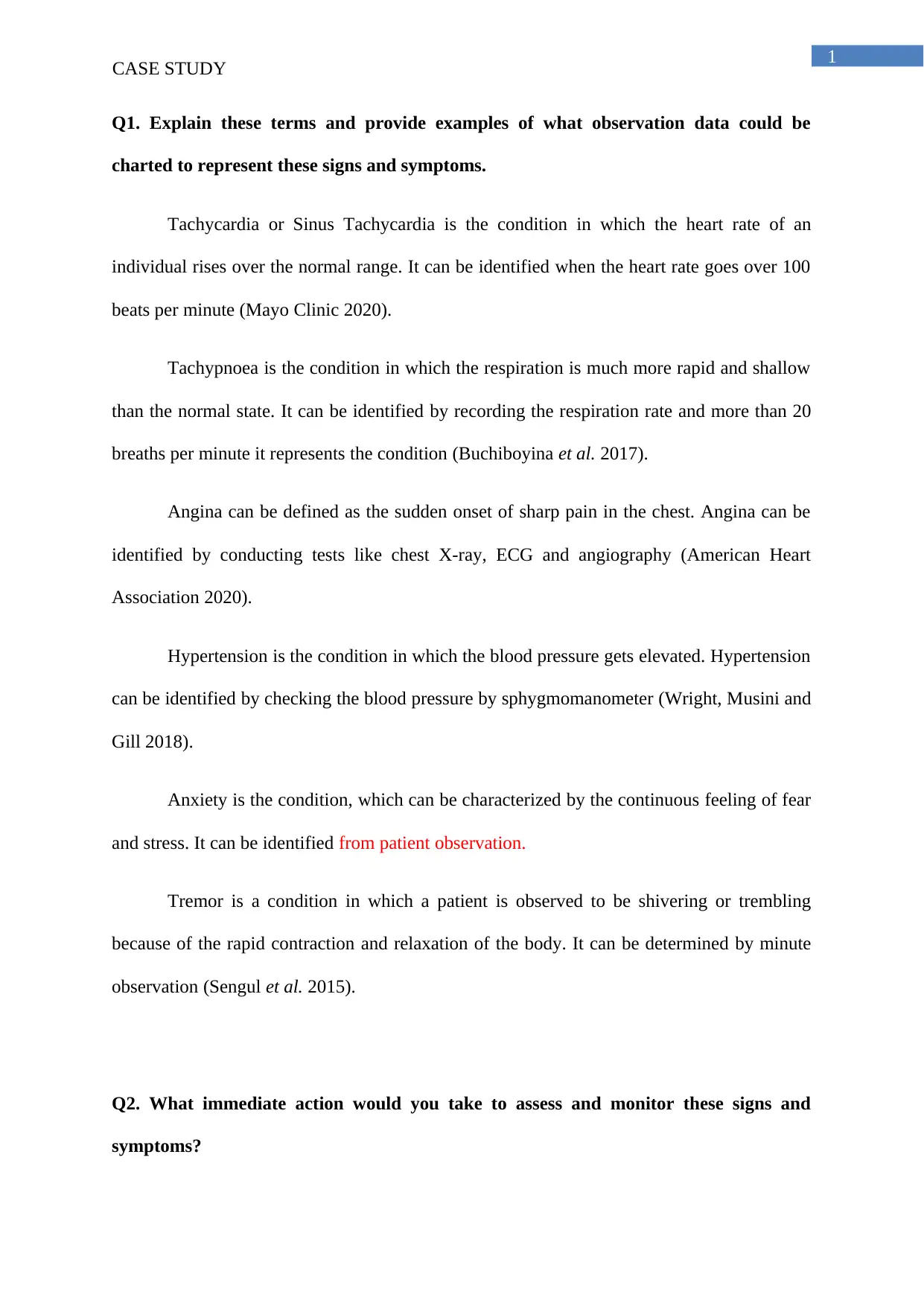
1
CASE STUDY
Q1. Explain these terms and provide examples of what observation data could be
charted to represent these signs and symptoms.
Tachycardia or Sinus Tachycardia is the condition in which the heart rate of an
individual rises over the normal range. It can be identified when the heart rate goes over 100
beats per minute (Mayo Clinic 2020).
Tachypnoea is the condition in which the respiration is much more rapid and shallow
than the normal state. It can be identified by recording the respiration rate and more than 20
breaths per minute it represents the condition (Buchiboyina et al. 2017).
Angina can be defined as the sudden onset of sharp pain in the chest. Angina can be
identified by conducting tests like chest X-ray, ECG and angiography (American Heart
Association 2020).
Hypertension is the condition in which the blood pressure gets elevated. Hypertension
can be identified by checking the blood pressure by sphygmomanometer (Wright, Musini and
Gill 2018).
Anxiety is the condition, which can be characterized by the continuous feeling of fear
and stress. It can be identified from patient observation.
Tremor is a condition in which a patient is observed to be shivering or trembling
because of the rapid contraction and relaxation of the body. It can be determined by minute
observation (Sengul et al. 2015).
Q2. What immediate action would you take to assess and monitor these signs and
symptoms?
CASE STUDY
Q1. Explain these terms and provide examples of what observation data could be
charted to represent these signs and symptoms.
Tachycardia or Sinus Tachycardia is the condition in which the heart rate of an
individual rises over the normal range. It can be identified when the heart rate goes over 100
beats per minute (Mayo Clinic 2020).
Tachypnoea is the condition in which the respiration is much more rapid and shallow
than the normal state. It can be identified by recording the respiration rate and more than 20
breaths per minute it represents the condition (Buchiboyina et al. 2017).
Angina can be defined as the sudden onset of sharp pain in the chest. Angina can be
identified by conducting tests like chest X-ray, ECG and angiography (American Heart
Association 2020).
Hypertension is the condition in which the blood pressure gets elevated. Hypertension
can be identified by checking the blood pressure by sphygmomanometer (Wright, Musini and
Gill 2018).
Anxiety is the condition, which can be characterized by the continuous feeling of fear
and stress. It can be identified from patient observation.
Tremor is a condition in which a patient is observed to be shivering or trembling
because of the rapid contraction and relaxation of the body. It can be determined by minute
observation (Sengul et al. 2015).
Q2. What immediate action would you take to assess and monitor these signs and
symptoms?

2
CASE STUDY
As an emergency nurse, it is my duty to provide optimum quality care to the patients
under my charge. Jolene on getting admitted to the hospital complained about various
discomforts that she was facing. Her first problem was increased heartbeat or Tachycardia for
which, I would administer her with antiarrhythmic drugs to reduce the increased heart
rhythm. She also had breathlessness or Tachypnoea for which I would provide her with
artificial respiration systems and some drugs to increase capability to inhale more oxygen
(Moon, 2015). Next, I would bring my attention towards her chest pain or angina for which I
would help her go through various tests such as angiography, chest X-ray and ECG. After
doing these, I would treat her anxiety and tremor by calming her down with comforting
words and in need, I would also provide her with sedatives as sleep plays a huge role in
calming oneself down. If it does not decrease after she wakes, I would bring in the
psychologist to calm her down and fill her with positivity (Calissendorff et al. 2015).
Q3. Explain the pathophysiology of Asthma.
Asthma is a disease that can be explained as the inflammation of airway leading to
obstruction on bronchi. Asthma arises from inhaling pollutants, pollens and consuming non-
steroidal inflammatory medicines. Regular chain smoking also causes asthma. Asthma can
occur to anyone because of variety of reasons. One such reason is the genetic disposition of
the disease. Another reason is the occurrence of Type 2 hypersensitive reaction. The
inflammation that takes place is due to the immune responses triggered by the immune
system of the body in the form of lymphocytes, histamines, mast cells and eosinophil. This
initiates a mechanism pathway that starts from alteration of the mucosal and submucosal
layer of the respiratory tract that further leads to hyperplasia and hypertrophy of the smooth
muscle (King et al. 2018). These changes and alterations of the respiratory system lead to the
obstruction of the bronchi making breathing difficulty.
CASE STUDY
As an emergency nurse, it is my duty to provide optimum quality care to the patients
under my charge. Jolene on getting admitted to the hospital complained about various
discomforts that she was facing. Her first problem was increased heartbeat or Tachycardia for
which, I would administer her with antiarrhythmic drugs to reduce the increased heart
rhythm. She also had breathlessness or Tachypnoea for which I would provide her with
artificial respiration systems and some drugs to increase capability to inhale more oxygen
(Moon, 2015). Next, I would bring my attention towards her chest pain or angina for which I
would help her go through various tests such as angiography, chest X-ray and ECG. After
doing these, I would treat her anxiety and tremor by calming her down with comforting
words and in need, I would also provide her with sedatives as sleep plays a huge role in
calming oneself down. If it does not decrease after she wakes, I would bring in the
psychologist to calm her down and fill her with positivity (Calissendorff et al. 2015).
Q3. Explain the pathophysiology of Asthma.
Asthma is a disease that can be explained as the inflammation of airway leading to
obstruction on bronchi. Asthma arises from inhaling pollutants, pollens and consuming non-
steroidal inflammatory medicines. Regular chain smoking also causes asthma. Asthma can
occur to anyone because of variety of reasons. One such reason is the genetic disposition of
the disease. Another reason is the occurrence of Type 2 hypersensitive reaction. The
inflammation that takes place is due to the immune responses triggered by the immune
system of the body in the form of lymphocytes, histamines, mast cells and eosinophil. This
initiates a mechanism pathway that starts from alteration of the mucosal and submucosal
layer of the respiratory tract that further leads to hyperplasia and hypertrophy of the smooth
muscle (King et al. 2018). These changes and alterations of the respiratory system lead to the
obstruction of the bronchi making breathing difficulty.
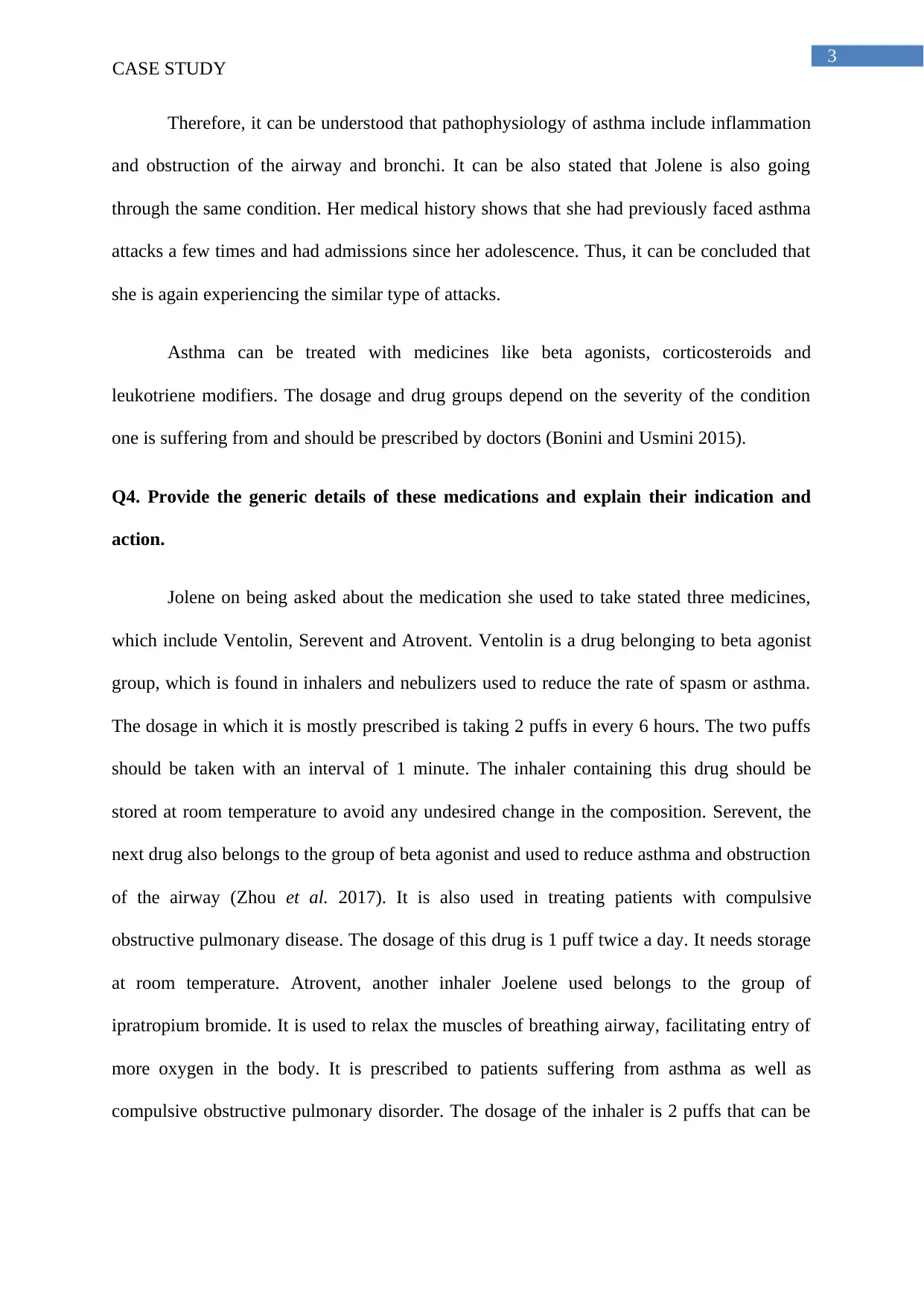
3
CASE STUDY
Therefore, it can be understood that pathophysiology of asthma include inflammation
and obstruction of the airway and bronchi. It can be also stated that Jolene is also going
through the same condition. Her medical history shows that she had previously faced asthma
attacks a few times and had admissions since her adolescence. Thus, it can be concluded that
she is again experiencing the similar type of attacks.
Asthma can be treated with medicines like beta agonists, corticosteroids and
leukotriene modifiers. The dosage and drug groups depend on the severity of the condition
one is suffering from and should be prescribed by doctors (Bonini and Usmini 2015).
Q4. Provide the generic details of these medications and explain their indication and
action.
Jolene on being asked about the medication she used to take stated three medicines,
which include Ventolin, Serevent and Atrovent. Ventolin is a drug belonging to beta agonist
group, which is found in inhalers and nebulizers used to reduce the rate of spasm or asthma.
The dosage in which it is mostly prescribed is taking 2 puffs in every 6 hours. The two puffs
should be taken with an interval of 1 minute. The inhaler containing this drug should be
stored at room temperature to avoid any undesired change in the composition. Serevent, the
next drug also belongs to the group of beta agonist and used to reduce asthma and obstruction
of the airway (Zhou et al. 2017). It is also used in treating patients with compulsive
obstructive pulmonary disease. The dosage of this drug is 1 puff twice a day. It needs storage
at room temperature. Atrovent, another inhaler Joelene used belongs to the group of
ipratropium bromide. It is used to relax the muscles of breathing airway, facilitating entry of
more oxygen in the body. It is prescribed to patients suffering from asthma as well as
compulsive obstructive pulmonary disorder. The dosage of the inhaler is 2 puffs that can be
CASE STUDY
Therefore, it can be understood that pathophysiology of asthma include inflammation
and obstruction of the airway and bronchi. It can be also stated that Jolene is also going
through the same condition. Her medical history shows that she had previously faced asthma
attacks a few times and had admissions since her adolescence. Thus, it can be concluded that
she is again experiencing the similar type of attacks.
Asthma can be treated with medicines like beta agonists, corticosteroids and
leukotriene modifiers. The dosage and drug groups depend on the severity of the condition
one is suffering from and should be prescribed by doctors (Bonini and Usmini 2015).
Q4. Provide the generic details of these medications and explain their indication and
action.
Jolene on being asked about the medication she used to take stated three medicines,
which include Ventolin, Serevent and Atrovent. Ventolin is a drug belonging to beta agonist
group, which is found in inhalers and nebulizers used to reduce the rate of spasm or asthma.
The dosage in which it is mostly prescribed is taking 2 puffs in every 6 hours. The two puffs
should be taken with an interval of 1 minute. The inhaler containing this drug should be
stored at room temperature to avoid any undesired change in the composition. Serevent, the
next drug also belongs to the group of beta agonist and used to reduce asthma and obstruction
of the airway (Zhou et al. 2017). It is also used in treating patients with compulsive
obstructive pulmonary disease. The dosage of this drug is 1 puff twice a day. It needs storage
at room temperature. Atrovent, another inhaler Joelene used belongs to the group of
ipratropium bromide. It is used to relax the muscles of breathing airway, facilitating entry of
more oxygen in the body. It is prescribed to patients suffering from asthma as well as
compulsive obstructive pulmonary disorder. The dosage of the inhaler is 2 puffs that can be
Secure Best Marks with AI Grader
Need help grading? Try our AI Grader for instant feedback on your assignments.
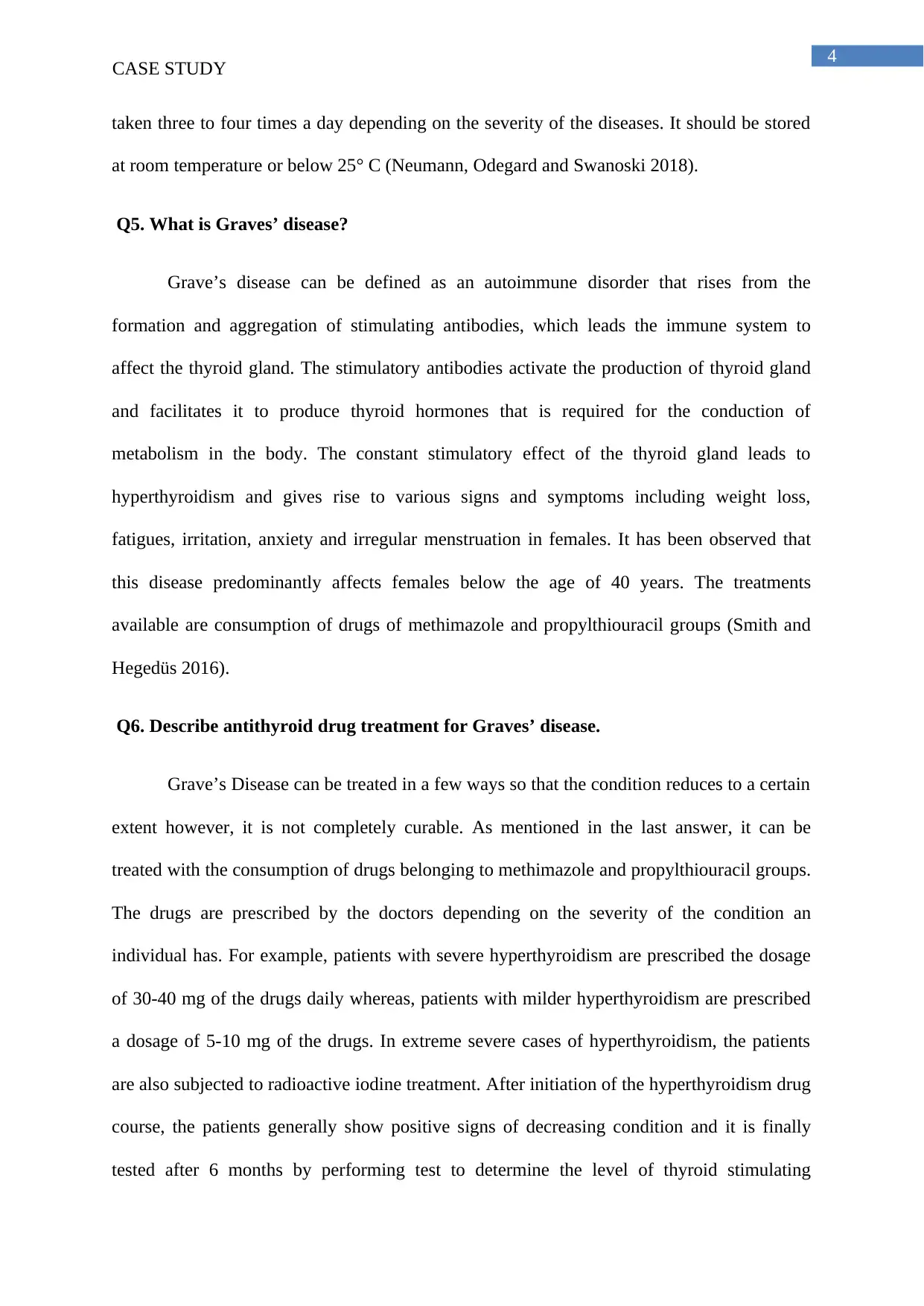
4
CASE STUDY
taken three to four times a day depending on the severity of the diseases. It should be stored
at room temperature or below 25° C (Neumann, Odegard and Swanoski 2018).
Q5. What is Graves’ disease?
Grave’s disease can be defined as an autoimmune disorder that rises from the
formation and aggregation of stimulating antibodies, which leads the immune system to
affect the thyroid gland. The stimulatory antibodies activate the production of thyroid gland
and facilitates it to produce thyroid hormones that is required for the conduction of
metabolism in the body. The constant stimulatory effect of the thyroid gland leads to
hyperthyroidism and gives rise to various signs and symptoms including weight loss,
fatigues, irritation, anxiety and irregular menstruation in females. It has been observed that
this disease predominantly affects females below the age of 40 years. The treatments
available are consumption of drugs of methimazole and propylthiouracil groups (Smith and
Hegedüs 2016).
Q6. Describe antithyroid drug treatment for Graves’ disease.
Grave’s Disease can be treated in a few ways so that the condition reduces to a certain
extent however, it is not completely curable. As mentioned in the last answer, it can be
treated with the consumption of drugs belonging to methimazole and propylthiouracil groups.
The drugs are prescribed by the doctors depending on the severity of the condition an
individual has. For example, patients with severe hyperthyroidism are prescribed the dosage
of 30-40 mg of the drugs daily whereas, patients with milder hyperthyroidism are prescribed
a dosage of 5-10 mg of the drugs. In extreme severe cases of hyperthyroidism, the patients
are also subjected to radioactive iodine treatment. After initiation of the hyperthyroidism drug
course, the patients generally show positive signs of decreasing condition and it is finally
tested after 6 months by performing test to determine the level of thyroid stimulating
CASE STUDY
taken three to four times a day depending on the severity of the diseases. It should be stored
at room temperature or below 25° C (Neumann, Odegard and Swanoski 2018).
Q5. What is Graves’ disease?
Grave’s disease can be defined as an autoimmune disorder that rises from the
formation and aggregation of stimulating antibodies, which leads the immune system to
affect the thyroid gland. The stimulatory antibodies activate the production of thyroid gland
and facilitates it to produce thyroid hormones that is required for the conduction of
metabolism in the body. The constant stimulatory effect of the thyroid gland leads to
hyperthyroidism and gives rise to various signs and symptoms including weight loss,
fatigues, irritation, anxiety and irregular menstruation in females. It has been observed that
this disease predominantly affects females below the age of 40 years. The treatments
available are consumption of drugs of methimazole and propylthiouracil groups (Smith and
Hegedüs 2016).
Q6. Describe antithyroid drug treatment for Graves’ disease.
Grave’s Disease can be treated in a few ways so that the condition reduces to a certain
extent however, it is not completely curable. As mentioned in the last answer, it can be
treated with the consumption of drugs belonging to methimazole and propylthiouracil groups.
The drugs are prescribed by the doctors depending on the severity of the condition an
individual has. For example, patients with severe hyperthyroidism are prescribed the dosage
of 30-40 mg of the drugs daily whereas, patients with milder hyperthyroidism are prescribed
a dosage of 5-10 mg of the drugs. In extreme severe cases of hyperthyroidism, the patients
are also subjected to radioactive iodine treatment. After initiation of the hyperthyroidism drug
course, the patients generally show positive signs of decreasing condition and it is finally
tested after 6 months by performing test to determine the level of thyroid stimulating
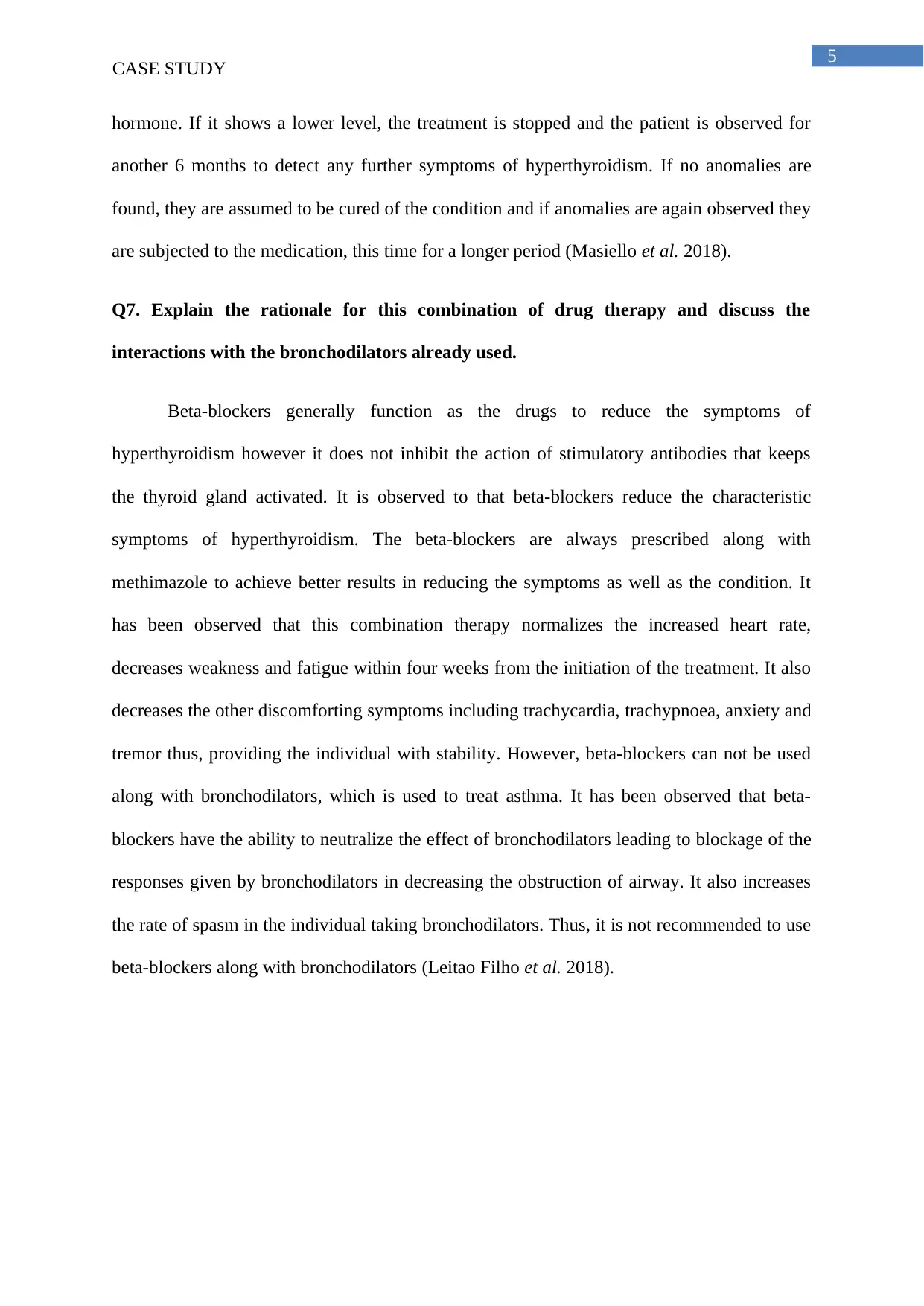
5
CASE STUDY
hormone. If it shows a lower level, the treatment is stopped and the patient is observed for
another 6 months to detect any further symptoms of hyperthyroidism. If no anomalies are
found, they are assumed to be cured of the condition and if anomalies are again observed they
are subjected to the medication, this time for a longer period (Masiello et al. 2018).
Q7. Explain the rationale for this combination of drug therapy and discuss the
interactions with the bronchodilators already used.
Beta-blockers generally function as the drugs to reduce the symptoms of
hyperthyroidism however it does not inhibit the action of stimulatory antibodies that keeps
the thyroid gland activated. It is observed to that beta-blockers reduce the characteristic
symptoms of hyperthyroidism. The beta-blockers are always prescribed along with
methimazole to achieve better results in reducing the symptoms as well as the condition. It
has been observed that this combination therapy normalizes the increased heart rate,
decreases weakness and fatigue within four weeks from the initiation of the treatment. It also
decreases the other discomforting symptoms including trachycardia, trachypnoea, anxiety and
tremor thus, providing the individual with stability. However, beta-blockers can not be used
along with bronchodilators, which is used to treat asthma. It has been observed that beta-
blockers have the ability to neutralize the effect of bronchodilators leading to blockage of the
responses given by bronchodilators in decreasing the obstruction of airway. It also increases
the rate of spasm in the individual taking bronchodilators. Thus, it is not recommended to use
beta-blockers along with bronchodilators (Leitao Filho et al. 2018).
CASE STUDY
hormone. If it shows a lower level, the treatment is stopped and the patient is observed for
another 6 months to detect any further symptoms of hyperthyroidism. If no anomalies are
found, they are assumed to be cured of the condition and if anomalies are again observed they
are subjected to the medication, this time for a longer period (Masiello et al. 2018).
Q7. Explain the rationale for this combination of drug therapy and discuss the
interactions with the bronchodilators already used.
Beta-blockers generally function as the drugs to reduce the symptoms of
hyperthyroidism however it does not inhibit the action of stimulatory antibodies that keeps
the thyroid gland activated. It is observed to that beta-blockers reduce the characteristic
symptoms of hyperthyroidism. The beta-blockers are always prescribed along with
methimazole to achieve better results in reducing the symptoms as well as the condition. It
has been observed that this combination therapy normalizes the increased heart rate,
decreases weakness and fatigue within four weeks from the initiation of the treatment. It also
decreases the other discomforting symptoms including trachycardia, trachypnoea, anxiety and
tremor thus, providing the individual with stability. However, beta-blockers can not be used
along with bronchodilators, which is used to treat asthma. It has been observed that beta-
blockers have the ability to neutralize the effect of bronchodilators leading to blockage of the
responses given by bronchodilators in decreasing the obstruction of airway. It also increases
the rate of spasm in the individual taking bronchodilators. Thus, it is not recommended to use
beta-blockers along with bronchodilators (Leitao Filho et al. 2018).
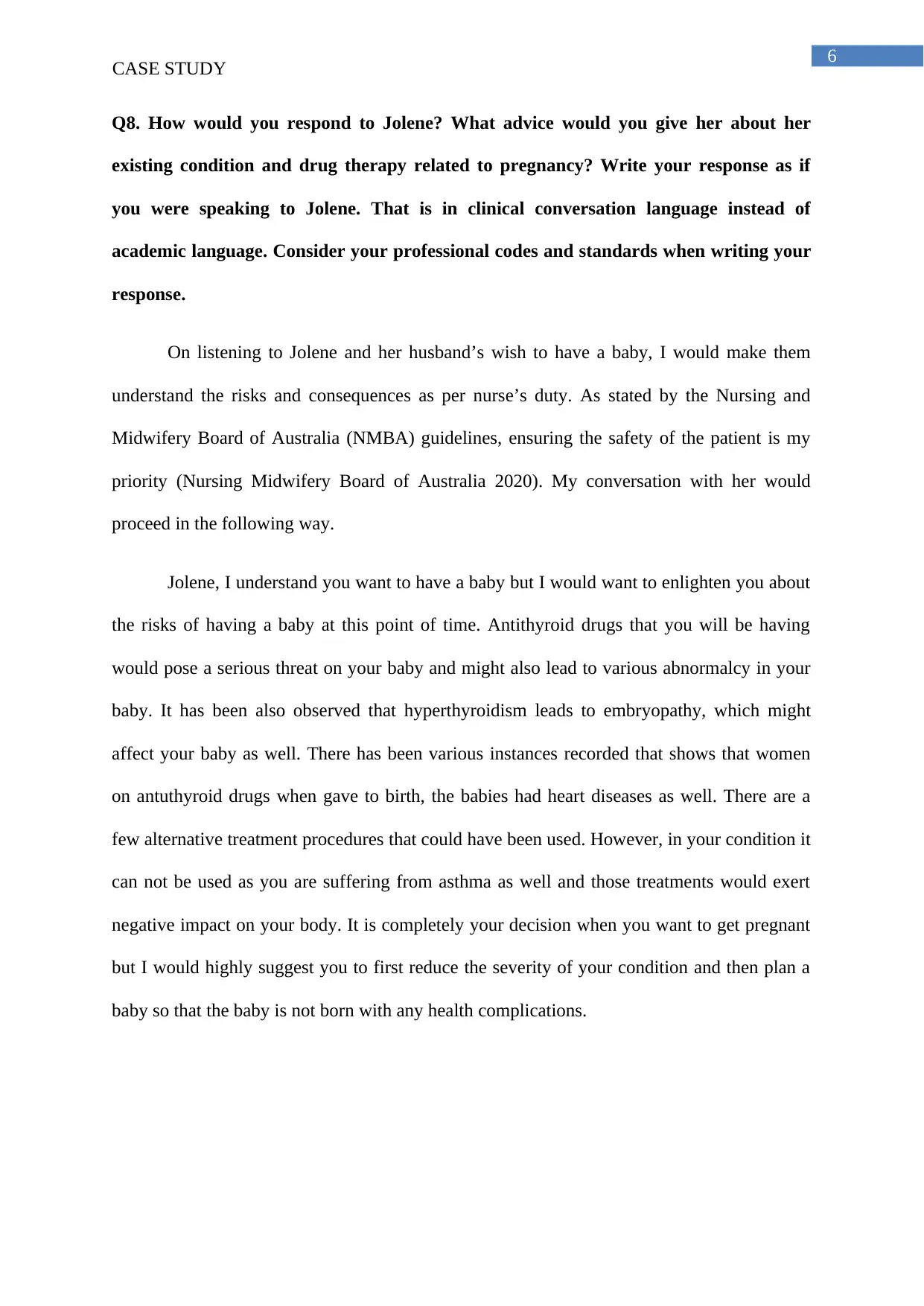
6
CASE STUDY
Q8. How would you respond to Jolene? What advice would you give her about her
existing condition and drug therapy related to pregnancy? Write your response as if
you were speaking to Jolene. That is in clinical conversation language instead of
academic language. Consider your professional codes and standards when writing your
response.
On listening to Jolene and her husband’s wish to have a baby, I would make them
understand the risks and consequences as per nurse’s duty. As stated by the Nursing and
Midwifery Board of Australia (NMBA) guidelines, ensuring the safety of the patient is my
priority (Nursing Midwifery Board of Australia 2020). My conversation with her would
proceed in the following way.
Jolene, I understand you want to have a baby but I would want to enlighten you about
the risks of having a baby at this point of time. Antithyroid drugs that you will be having
would pose a serious threat on your baby and might also lead to various abnormalcy in your
baby. It has been also observed that hyperthyroidism leads to embryopathy, which might
affect your baby as well. There has been various instances recorded that shows that women
on antuthyroid drugs when gave to birth, the babies had heart diseases as well. There are a
few alternative treatment procedures that could have been used. However, in your condition it
can not be used as you are suffering from asthma as well and those treatments would exert
negative impact on your body. It is completely your decision when you want to get pregnant
but I would highly suggest you to first reduce the severity of your condition and then plan a
baby so that the baby is not born with any health complications.
CASE STUDY
Q8. How would you respond to Jolene? What advice would you give her about her
existing condition and drug therapy related to pregnancy? Write your response as if
you were speaking to Jolene. That is in clinical conversation language instead of
academic language. Consider your professional codes and standards when writing your
response.
On listening to Jolene and her husband’s wish to have a baby, I would make them
understand the risks and consequences as per nurse’s duty. As stated by the Nursing and
Midwifery Board of Australia (NMBA) guidelines, ensuring the safety of the patient is my
priority (Nursing Midwifery Board of Australia 2020). My conversation with her would
proceed in the following way.
Jolene, I understand you want to have a baby but I would want to enlighten you about
the risks of having a baby at this point of time. Antithyroid drugs that you will be having
would pose a serious threat on your baby and might also lead to various abnormalcy in your
baby. It has been also observed that hyperthyroidism leads to embryopathy, which might
affect your baby as well. There has been various instances recorded that shows that women
on antuthyroid drugs when gave to birth, the babies had heart diseases as well. There are a
few alternative treatment procedures that could have been used. However, in your condition it
can not be used as you are suffering from asthma as well and those treatments would exert
negative impact on your body. It is completely your decision when you want to get pregnant
but I would highly suggest you to first reduce the severity of your condition and then plan a
baby so that the baby is not born with any health complications.
Paraphrase This Document
Need a fresh take? Get an instant paraphrase of this document with our AI Paraphraser
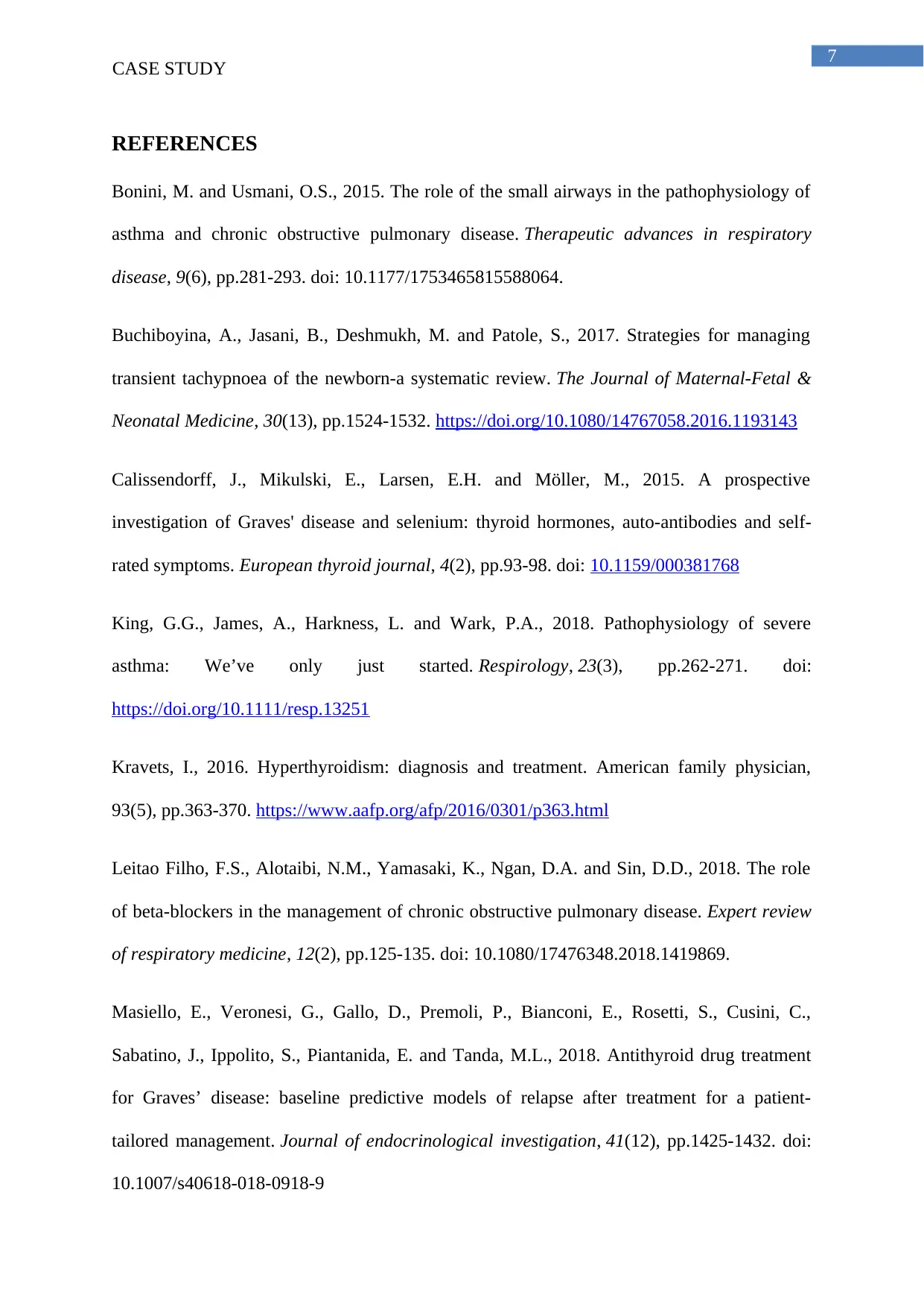
7
CASE STUDY
REFERENCES
Bonini, M. and Usmani, O.S., 2015. The role of the small airways in the pathophysiology of
asthma and chronic obstructive pulmonary disease. Therapeutic advances in respiratory
disease, 9(6), pp.281-293. doi: 10.1177/1753465815588064.
Buchiboyina, A., Jasani, B., Deshmukh, M. and Patole, S., 2017. Strategies for managing
transient tachypnoea of the newborn-a systematic review. The Journal of Maternal-Fetal &
Neonatal Medicine, 30(13), pp.1524-1532. https://doi.org/10.1080/14767058.2016.1193143
Calissendorff, J., Mikulski, E., Larsen, E.H. and Möller, M., 2015. A prospective
investigation of Graves' disease and selenium: thyroid hormones, auto-antibodies and self-
rated symptoms. European thyroid journal, 4(2), pp.93-98. doi: 10.1159/000381768
King, G.G., James, A., Harkness, L. and Wark, P.A., 2018. Pathophysiology of severe
asthma: We’ve only just started. Respirology, 23(3), pp.262-271. doi:
https://doi.org/10.1111/resp.13251
Kravets, I., 2016. Hyperthyroidism: diagnosis and treatment. American family physician,
93(5), pp.363-370. https://www.aafp.org/afp/2016/0301/p363.html
Leitao Filho, F.S., Alotaibi, N.M., Yamasaki, K., Ngan, D.A. and Sin, D.D., 2018. The role
of beta-blockers in the management of chronic obstructive pulmonary disease. Expert review
of respiratory medicine, 12(2), pp.125-135. doi: 10.1080/17476348.2018.1419869.
Masiello, E., Veronesi, G., Gallo, D., Premoli, P., Bianconi, E., Rosetti, S., Cusini, C.,
Sabatino, J., Ippolito, S., Piantanida, E. and Tanda, M.L., 2018. Antithyroid drug treatment
for Graves’ disease: baseline predictive models of relapse after treatment for a patient-
tailored management. Journal of endocrinological investigation, 41(12), pp.1425-1432. doi:
10.1007/s40618-018-0918-9
CASE STUDY
REFERENCES
Bonini, M. and Usmani, O.S., 2015. The role of the small airways in the pathophysiology of
asthma and chronic obstructive pulmonary disease. Therapeutic advances in respiratory
disease, 9(6), pp.281-293. doi: 10.1177/1753465815588064.
Buchiboyina, A., Jasani, B., Deshmukh, M. and Patole, S., 2017. Strategies for managing
transient tachypnoea of the newborn-a systematic review. The Journal of Maternal-Fetal &
Neonatal Medicine, 30(13), pp.1524-1532. https://doi.org/10.1080/14767058.2016.1193143
Calissendorff, J., Mikulski, E., Larsen, E.H. and Möller, M., 2015. A prospective
investigation of Graves' disease and selenium: thyroid hormones, auto-antibodies and self-
rated symptoms. European thyroid journal, 4(2), pp.93-98. doi: 10.1159/000381768
King, G.G., James, A., Harkness, L. and Wark, P.A., 2018. Pathophysiology of severe
asthma: We’ve only just started. Respirology, 23(3), pp.262-271. doi:
https://doi.org/10.1111/resp.13251
Kravets, I., 2016. Hyperthyroidism: diagnosis and treatment. American family physician,
93(5), pp.363-370. https://www.aafp.org/afp/2016/0301/p363.html
Leitao Filho, F.S., Alotaibi, N.M., Yamasaki, K., Ngan, D.A. and Sin, D.D., 2018. The role
of beta-blockers in the management of chronic obstructive pulmonary disease. Expert review
of respiratory medicine, 12(2), pp.125-135. doi: 10.1080/17476348.2018.1419869.
Masiello, E., Veronesi, G., Gallo, D., Premoli, P., Bianconi, E., Rosetti, S., Cusini, C.,
Sabatino, J., Ippolito, S., Piantanida, E. and Tanda, M.L., 2018. Antithyroid drug treatment
for Graves’ disease: baseline predictive models of relapse after treatment for a patient-
tailored management. Journal of endocrinological investigation, 41(12), pp.1425-1432. doi:
10.1007/s40618-018-0918-9

8
CASE STUDY
Mayo Clinic, 2020. Tachycardia - Symptoms And Causes. [online] Mayo Clinic. Available at:
<https://www.mayoclinic.org/diseases-conditions/tachycardia/symptoms-causes/syc-
20355127> [Accessed 3 April 2020].
Moon, W., 2015. Disseminated histoplasmosis: case report. Reactions, 1569, pp.178-19.
https://search.proquest.com/openview/bb094f4277f40e95abfb52a1eecd0d88/1?pq-
origsite=gscholar&cbl=43703
Neumann, N., Odegard, P. and Swanoski, M., 2018. Considerations for Geriatric Patients
with COPD. The Consultant Pharmacist®, 33(4), pp.210-214. DOI: 10.4140/tcp.n.2018.210
Professional Standards. Nursing Midwifery Board of Australia. [online] Available at:
<https://www.nursingmidwiferyboard.gov.au/Codes-Guidelines-Statements/Professional-
standards.aspx> [Accessed 03 April 2020].
Sengul, Y., Sengul, H.S., Yucekaya, S.K., Yucel, S., Bakim, B., Pazarcı, N.K. and Özdemir,
G., 2015. Cognitive functions, fatigue, depression, anxiety, and sleep disturbances:
assessment of nonmotor features in young patients with essential tremor. Acta Neurologica
Belgica, 115(3), pp.281-287. doi: 10.1007/s13760-014-0396-6.
Smith, T.J. and Hegedüs, L., 2016. Graves’ disease. New England Journal of
Medicine, 375(16), pp.1552-1565. DOI: 10.1056/NEJMra1510030
Wright, J.M., Musini, V.M. and Gill, R., 2018. First‐line drugs for hypertension. Cochrane
Database of systematic reviews, (4). doi: 10.1002/14651858.CD001841.pub3.
Zhou, E.H., Seymour, S., Goulding, M.R., Kang, E.M., Major, J.M. and Iyasu, S., 2017. The
US Food and Drug Administration’s drug safety recommendations and long-acting beta2-
agonist dispensing pattern changes in adult asthma patients: 2003–2012. Journal of asthma
and allergy, 10, p.67. doi: 10.2147/JAA.S124395
CASE STUDY
Mayo Clinic, 2020. Tachycardia - Symptoms And Causes. [online] Mayo Clinic. Available at:
<https://www.mayoclinic.org/diseases-conditions/tachycardia/symptoms-causes/syc-
20355127> [Accessed 3 April 2020].
Moon, W., 2015. Disseminated histoplasmosis: case report. Reactions, 1569, pp.178-19.
https://search.proquest.com/openview/bb094f4277f40e95abfb52a1eecd0d88/1?pq-
origsite=gscholar&cbl=43703
Neumann, N., Odegard, P. and Swanoski, M., 2018. Considerations for Geriatric Patients
with COPD. The Consultant Pharmacist®, 33(4), pp.210-214. DOI: 10.4140/tcp.n.2018.210
Professional Standards. Nursing Midwifery Board of Australia. [online] Available at:
<https://www.nursingmidwiferyboard.gov.au/Codes-Guidelines-Statements/Professional-
standards.aspx> [Accessed 03 April 2020].
Sengul, Y., Sengul, H.S., Yucekaya, S.K., Yucel, S., Bakim, B., Pazarcı, N.K. and Özdemir,
G., 2015. Cognitive functions, fatigue, depression, anxiety, and sleep disturbances:
assessment of nonmotor features in young patients with essential tremor. Acta Neurologica
Belgica, 115(3), pp.281-287. doi: 10.1007/s13760-014-0396-6.
Smith, T.J. and Hegedüs, L., 2016. Graves’ disease. New England Journal of
Medicine, 375(16), pp.1552-1565. DOI: 10.1056/NEJMra1510030
Wright, J.M., Musini, V.M. and Gill, R., 2018. First‐line drugs for hypertension. Cochrane
Database of systematic reviews, (4). doi: 10.1002/14651858.CD001841.pub3.
Zhou, E.H., Seymour, S., Goulding, M.R., Kang, E.M., Major, J.M. and Iyasu, S., 2017. The
US Food and Drug Administration’s drug safety recommendations and long-acting beta2-
agonist dispensing pattern changes in adult asthma patients: 2003–2012. Journal of asthma
and allergy, 10, p.67. doi: 10.2147/JAA.S124395
1 out of 9
Related Documents
Your All-in-One AI-Powered Toolkit for Academic Success.
+13062052269
info@desklib.com
Available 24*7 on WhatsApp / Email
![[object Object]](/_next/static/media/star-bottom.7253800d.svg)
Unlock your academic potential
© 2024 | Zucol Services PVT LTD | All rights reserved.





